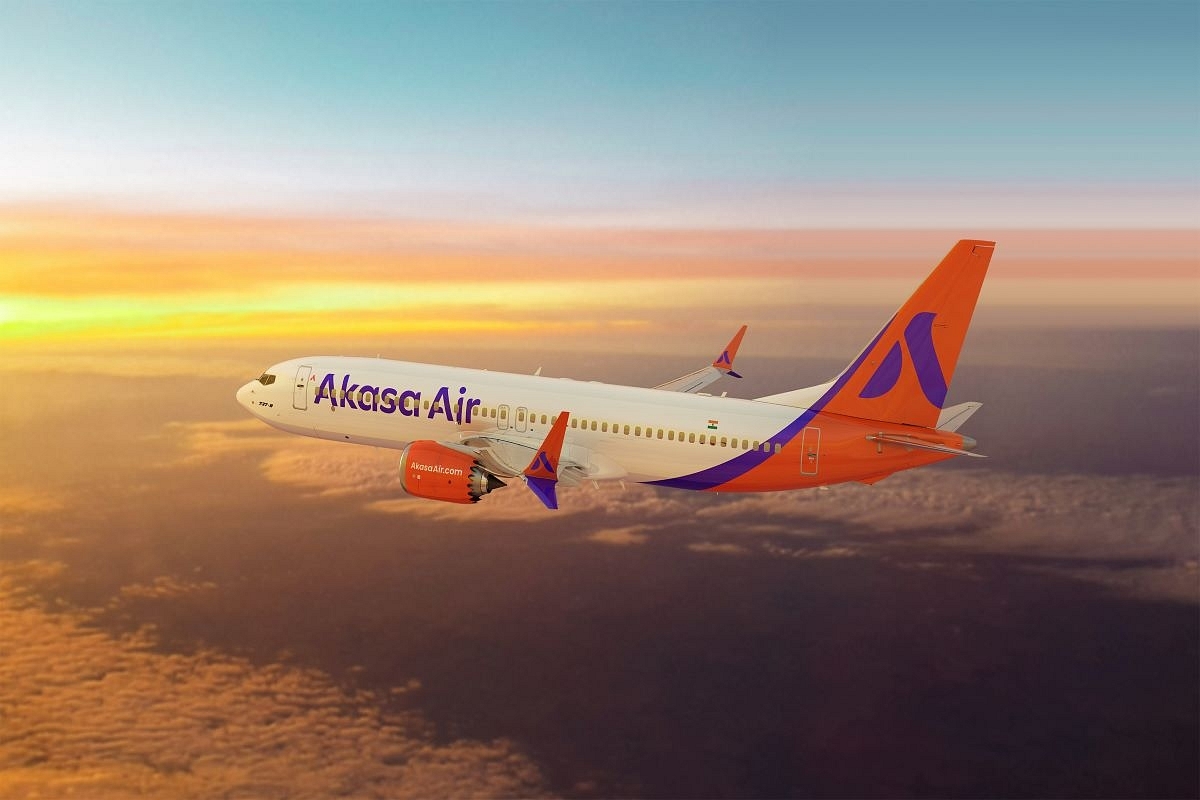Context
How Akasa Air Plans To Take Off From A Crowded Field

Akasa Air
Backed by the recently deceased Rakesh Jhunjhunwala, Akasa Air has entered Indian aviation as it looks to make a name as a low-cost carrier.
To the skies: Akasa Air completed its maiden flight from Mumbai to Ahmedabad on 7 August.
Minister of Civil Aviation Jyotiraditya M Scindia and Minister of State for Civil Aviation Gen (Retired) V K Singh inaugurated the debut flight in the presence of Jhunjhunwala, Rekha Jhunjhunwala, and Akasa founder-CEO Vinay Dube.
Turbulence in the air: The last two years were quite painful for the aviation sector, with the Covid-19 pandemic, high fuel prices, and human resource shortages leaving air players with huge losses and debt burdens.
Some financially burdened companies have already reduced flights on certain routes where they do not have a chance to compete.
Challenging IndiGo: So far, IndiGo has dominated the Indian skies by edging out other players with a firm hold on costs.
While incumbents like SpiceJet, Go First, and AirAsia are yet to make a significant dent in IndiGo's operations, Akasa has a shot with its clean slate.
Akasa's strategy: The company has entered a market where incumbents are struggling financially.
Akasa plans on taking advantage of this weakness by being an ultra-low-cost carrier (ULCC).
ULCCs usually keep the fares low by separating the charges for aspects like luggage check-in and food.
No Indian operator has worked on the ULCC model thus far.
Akasa's fleet will have 72 Boeing 737 MAX airplanes, powered by CFM fuel-efficient, LEAP-1B engines.
By March 2023, the airline will have inducted 18 aircraft.
After that, 12-14 aircraft will be inducted every 12 months en route to its target of 72 airplanes over five years.
A younger fleet will ensure fuel efficiency.
Possessing similar aircraft will reduce retraining costs for staff and make maintenance and repair convenient.
Why Boeing: Boeing claims that the 737 Max range is the most fuel-efficient flight.
This lowers the per seat mile cost.
In the commodity business, lower costs mean higher profits; fuel efficiency helps control the costs.
Note that Boeing 737 Max had been out of the market due to technical issues that regulators wanted the company to sort out before the plane could fly again. Boeing possibly offered Akasa significant discounts as it looks to reclaim the market share it lost to Airbus.
Akasa's initial selection of routes shows its focus on short routes connecting large cities. However, with some weaker players reducing the number of flights on several routes, Akasa plans to scale up its operations on those routes.
The UDAN scheme for ensuring air connectivity between tier-2 and tier-3 cities is also a factor for the company.
Prior to Akasa's first flight, Scindia said, "Under the UDAN scheme, we have 425 routes aiming to go up to 1,000 routes, 68 new airports aiming to touch 100 airports. In the next four years, we are expecting 40 crore travellers through civil aviation in India."
Bottom line: Jet Airways' re-entry, Akasa's launch, and the Air India buyout point to a growing optimism in India's airline sector.
As for Akasa, whether it can emulate Ryanair or Southwest Airlines in terms of sustaining a low cost and consistent profitability will have to be seen.
Support Swarajya's 50 Ground Reports Project & Sponsor A Story
Every general election Swarajya does a 50 ground reports project.
Aimed only at serious readers and those who appreciate the nuances of political undercurrents, the project provides a sense of India's electoral landscape. As you know, these reports are produced after considerable investment of travel, time and effort on the ground.
This time too we've kicked off the project in style and have covered over 30 constituencies already. If you're someone who appreciates such work and have enjoyed our coverage please consider sponsoring a ground report for just Rs 2999 to Rs 19,999 - it goes a long way in helping us produce more quality reportage.
You can also back this project by becoming a subscriber for as little as Rs 999 - so do click on this links and choose a plan that suits you and back us.
Click below to contribute.
Latest